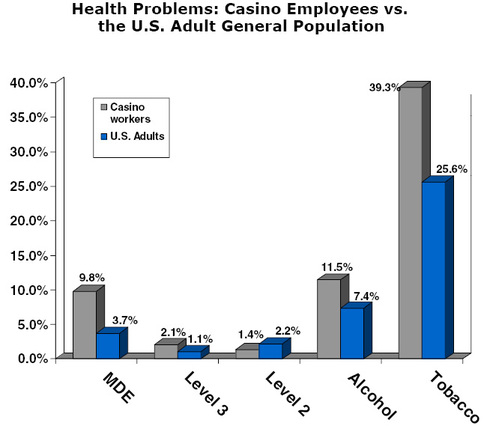The WAGER Vol. 5(9) – On the Job: Gambling Behavior among Casino Employees
Are people who work in casinos more likely to be pathological gamblers than their counterparts in the general population? Shaffer, Vander Bilt, and Hall (1999) set out to answer this question by surveying a large sample of casino employees.1 During the winter of 1997/1998, the investigators collected health-related data from 3,852 workers employed by a large gaming corporation. To protect the anonymity of both employer and employees, the gaming corporation will be referred to by a pseudonym: Casino, Inc.
In addition to an array of items relating to general health, the survey instrument included the South Oaks Gambling Screen (SOGS), the CAGE (a 4-item screen for alcohol problems), and questions about tobacco use and major depressive episodes (MDE). The results are presented in the table below.
Casino employees evidence a relatively higher prevalence of depressive episodes, alcohol problems, and tobacco use compared to the general population. Most interesting, however, are the gambling-related findings. Workers at Casino, Inc. are more likely to be level 3 gamblers ("pathological gamblers;" SOGS= 5+), but less likely to be level 2 gamblers ("problem gamblers;" SOGS= 3 or 4). Why is this? One might expect that constant access to gambling might lead to higher levels of both level 2 and level 3 gambling.
The authors provide a possible explanation: Casino employees directly witness the problems that gambling can cause. This understanding of the dangers of gambling serves as a protective factor against the development of sub-clinical, level 2 problem gambling. However, this firsthand knowledge may not be strong enough to deter and prevent level 3 pathological gambling.
One criticism of the present study is that no matched control group was assembled. Thus, any comparison between casino employees and other workers of similar socioeconomic status in other industries is unavailable.
This leaves one important question unanswered by the data collected during this study: Does working in a casino place employees at a higher risk for pathological gambling, or are people already with a high risk drawn to working in a casino? This is the gambling studies version of the classic "chicken and egg" paradox. But unlike the chicken and egg question, the questions raised by the present study can be answered by prospective research.
1 In the interest of disclosure, it should be noted that all three authors are editors of the WAGER.
References
Shaffer, H.J., Vander Bilt, J., & Hall, M.N. (1999). Gambling, drinking, smoking, and other health risk activities among casino employees. American Journal of Industrial Medicine, 36, 365-378.
